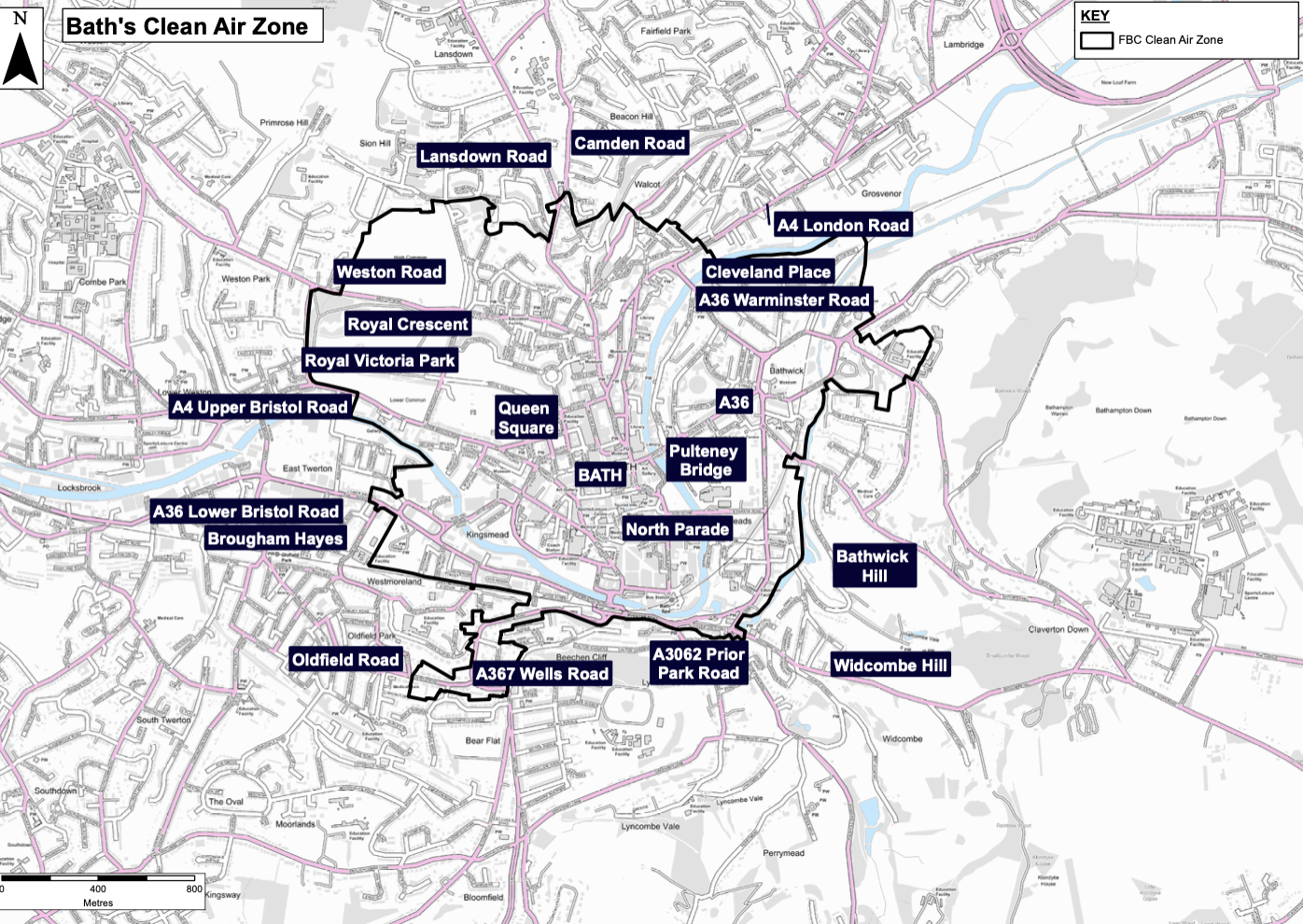Bath’s Clean Air Zone
Bath has a class C clean air zone, which means that charges only apply to taxis, private hire vehicles, vans, light goods vehicles, buses, coaches and heavy goods vehicles that do not meet the required emission standards.
New Sydney Place Action Group campaigned in collaboration with PERA for New Sydney Place and the whole of the Pulteney Estate be included in the zone (see map below).
This was a major achievement, without which we would have been unable to apply to be a Low Traffic Neighbourhood (LTN).

Air quality
Several places in Bath currently exceed the legal limits for nitrogen dioxide (NO2) pollution which is mainly caused by vehicle emissions. This situation is unacceptable because of the role that poor air quality plays in damaging health.
The legal limit for concentrations of nitrogen dioxide (NO2) is 40μg/m3 as an annual average. You can view air quality monitoring data for the area at our air quality web pages.
You can view air quality monitoring data for the area at the B&NES air quality web pages.
The monitoring site on London Road (‘Bath A4 Roadside’) provides live data for nitrogen dioxide as part of the Automatic Urban and Rural Network (AURN) and the latest raw data for the last hour is available here. A graph of the last 7 days of raw data is available here.
Bath's Clean Air Zone will help the city meet UK air quality legislation.
Source: The purpose of Bath’s Clean Air Zone, B&NES council
Health impacts
Unfortunately, poor air quality is harmful to our most vulnerable residents – children, elderly people and those already unwell. High levels of NO2 can cause:
- Inflammation of the airways, coughing and shortness of breath (short-term exposure)
- Worsening of existing lung or heart conditions, including asthma, emphysema and bronchitis (COPD)
- Increased susceptibility to allergens and respiratory infections
Over the long-term, high levels of NO2 can affect children’s lung development, and there is evidence that children who grow up in highly polluted areas are more likely to develop asthma.
Research also links high levels of NO2 with increased possibility of heart attack and dementia. Nitrogen dioxide pollution is thought to contribute to as many as 36,000 early deaths in the UK each year.
Source: The purpose of Bath’s Clean Air Zone, B&NES council
Background
In 2017, the government directed the B&NES council to reduce levels of nitrogen dioxide in the city in the shortest possible time. It is providing all of the funds for this, and the Joint Air Quality Unit (JAQU) is independently verifying all of the work being done.
Technical work has shown that a charging zone for traffic is the only measure that can achieve compliance in the required time frame – effectively deterring the majority of higher emission vehicles from driving in the inner city area by charging them to drive into the zone.
Following a public consultation in October/November 2018, the council agreed to introduce a class C charging clean air zone with traffic management at Queen Square, charging all higher emission vehicles, except private cars and motorcycles, to drive in Bath’s city centre from 15 March 2021.
Traffic management in Queen Square is a necessary compromise to avoid charging private cars. It also helps to moderate traffic flow to other parts of the city, where emissions would rise to unacceptable levels if large queues were allowed to form.
For full, detailed information on the development of the CAZ, including impact assessments, please see the council’s Final Business Case Documents.
While private cars are not being charged, the council is currently looking at lots of ways to improve walking, cycling and public transport to encourage more people to choose more sustainable ways of getting around.
The council asks that all drivers consider whether or not they need to take their vehicle, and to consider walking, cycling or taking public transport instead, especially for shorter cross-city journeys.
Source: The purpose of Bath’s Clean Air Zone, B&NES council